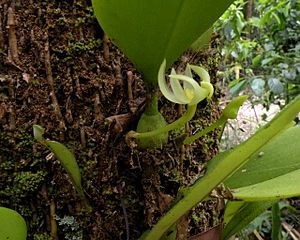Fruit fly orchid facts for kids
Quick facts for kids Fruit fly orchid |
|
|---|---|
 |
|
| Pale-coloured form of B. baileyi | |
| Scientific classification | |
| Genus: |
Bulbophyllum
|
| Species: |
baileyi
|
| Synonyms | |
The Bulbophyllum baileyi, also known as the fruit fly orchid, is a special type of orchid. It grows on other plants or rocks, but it doesn't harm them. This orchid is naturally found in Queensland, Australia, and in New Guinea.
It has thick, creeping stems called rhizomes. Its yellowish pseudobulbs (which look like swollen stems) are curved and have one thick, fleshy leaf. The orchid produces a single cream-coloured flower that often has yellow, red, or purple spots. You can find it growing on trees and rocks in open forests, sometimes in very exposed places.
Contents
What Does the Fruit Fly Orchid Look Like?
The fruit fly orchid is a herb that grows in spreading groups. It can grow on other plants (epiphytic) or on rocks (lithophytic). It has a creeping stem, called a rhizome, which is covered with brown leaf-like parts called bracts.
The orchid has curved, yellowish pseudobulbs that are about 15–30 mm (0.6–1 in) long and 10–15 mm (0.39–0.59 in) wide. Each pseudobulb has one thick, fleshy, light-coloured leaf. This leaf is shaped like an oblong or an egg and is about 80–200 mm (3–8 in) long and 40–60 mm (1.6–2.4 in) wide.
A single flower grows on a stem that is about 60–100 mm (2.4–3.9 in) long. The flower faces upwards and is cream-coloured to creamy yellow with red or purple spots. It is about 20–25 mm (0.79–0.98 in) long and 20–40 mm (0.79–1.6 in) wide.
The flower's sepals (outer leaf-like parts) and petals (inner colourful parts) curve inwards. The top sepal is narrow and triangular, about 20–25 mm (0.79–0.98 in) long. The side sepals are similar in length but a bit wider. The petals are about 15–18 mm (0.59–0.71 in) long. The labellum (a special lip-like petal) is fleshy and curved, about 5–6 mm (0.20–0.24 in) long, and has tiny spots. This orchid usually blooms between October and February.
How Did It Get Its Name?
The Bulbophyllum baileyi was first officially described in 1875 by a scientist named Ferdinand von Mueller. He wrote about it in a book called Fragmenta phytographiae Australiae.
The plant he described was found by Frederick Manson Bailey growing on a tree near Rockingham Bay. The second part of the orchid's scientific name, baileyi, was chosen to honor Manson Bailey, who found the first example of this plant.
Where Does It Live?
The fruit fly orchid grows on trees, rocks, and cliff faces. You can find it in different types of forests, including mangroves and rainforests. It lives in New Guinea, some of the Torres Strait Islands, and in Australia's Cape York Peninsula. Its range extends south as far as the city of Townsville.
How Does It Reproduce?
The flowers of the Bulbophyllum baileyi orchid are pollinated by male fruit flies. These flies belong to a group called Bactrocera. The orchid's flowers attract the flies with a "fruity" smell. Scientists think the flies are looking for a chemical called zingerone, which they use to attract other fruit flies.
When a fruit fly lands on the orchid's labellum (the special lip petal), the labellum is very delicately balanced. It tips the insect into the column of the flower. As this happens, sticky packets of pollen (called pollinia) either attach to the fly's back or are left by the fly on the flower's receptive stigma (the part that receives pollen). This process helps the orchid make seeds and reproduce.
See also
 In Spanish: Bulbophyllum baileyi para niños
In Spanish: Bulbophyllum baileyi para niños

